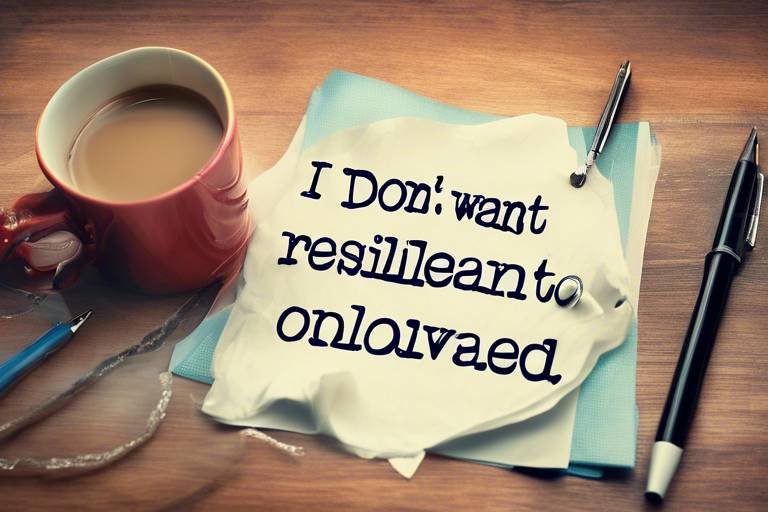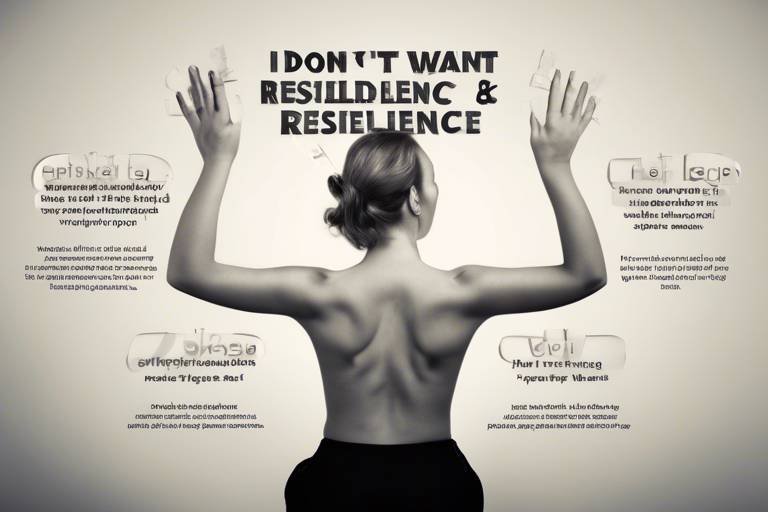How to Incorporate Resilience in Your Daily Habits?
In today's fast-paced world, the ability to bounce back from challenges is more crucial than ever. But how do we actually incorporate resilience into our daily lives? It’s not just about enduring tough times; it’s about actively building habits that foster emotional strength and adaptability. Imagine resilience as a muscle—just like any other, it requires regular exercise to grow stronger. So, let’s dive into some practical strategies that can help you develop this essential quality.
First and foremost, it’s important to recognize that resilience doesn’t magically appear overnight. It’s cultivated through consistent, intentional practices. One effective way to start is by establishing a daily routine that prioritizes your mental and emotional health. Think of your routine as a safety net—by creating a structure, you can better withstand the inevitable ups and downs of life. For example, begin your day with a few moments of mindfulness or meditation. This practice can ground you and set a positive tone for the day ahead.
Next, consider the power of positive affirmations. These are simple yet powerful statements that can help shift your mindset. By repeating affirmations like “I am capable of overcoming challenges” or “I learn and grow from my experiences,” you’re training your brain to adopt a more resilient outlook. It’s like planting seeds of positivity that will blossom into a strong, resilient mindset over time. Just like a garden requires care and attention, so does your mental landscape.
Another effective strategy is to embrace failure as a learning opportunity. Instead of fearing mistakes, reframe them as stepping stones toward growth. When you encounter a setback, ask yourself, “What can I learn from this?” This simple question can transform your perspective and help you develop resilience. Remember, the most successful people didn’t get there without facing challenges; they learned to adapt and grow from them.
Additionally, surrounding yourself with a supportive community can significantly enhance your resilience. Engage with friends, family, or support groups who uplift and encourage you. Having a network of people who believe in you can provide the strength needed to navigate tough times. Think of it as having a team cheering you on from the sidelines, ready to help you get back up when you stumble.
Finally, don’t underestimate the power of self-care. Prioritize activities that rejuvenate your spirit and bring you joy. Whether it’s reading a book, going for a walk, or indulging in a hobby, these moments of self-care can recharge your emotional batteries and build resilience. Just like a phone needs to be charged to function properly, so do you! Make self-care a non-negotiable part of your daily routine.
In summary, incorporating resilience into your daily habits is a multifaceted approach that requires intention and practice. By establishing a structured routine, practicing positive affirmations, embracing failure, surrounding yourself with support, and prioritizing self-care, you can build a robust framework for emotional strength. Remember, resilience is not about avoiding challenges but about developing the tools to face them head-on.
- What is resilience? Resilience is the ability to bounce back from adversity and adapt to challenges.
- How can I build resilience? You can build resilience by establishing daily routines, practicing positive affirmations, and embracing failure as a learning opportunity.
- Is self-care important for resilience? Absolutely! Self-care activities help recharge your emotional batteries and strengthen your ability to cope with stress.
- Can resilience be learned? Yes, resilience can be cultivated through consistent practice and intentional habits.

Understanding Resilience
This article explores practical strategies for building resilience into everyday life, enhancing emotional strength, and developing a mindset that can withstand challenges and setbacks.
Resilience is often described as the ability to bounce back from adversity, but it’s much more than just recovering from difficulties. It’s about thriving in the face of challenges and transforming setbacks into opportunities for growth. Think of resilience as a rubber band; it stretches and bends but always returns to its original shape. In our lives, this means that while we may face stressors, disappointments, or failures, we can develop the capacity to adapt and emerge even stronger.
Understanding the importance of resilience is crucial. It can positively impact your life in numerous ways, including:
- Improved Mental Health: Resilient individuals often experience lower rates of anxiety and depression.
- Enhanced Problem-Solving Skills: Resilience fosters creativity and resourcefulness when faced with challenges.
- Stronger Relationships: Resilience can help you maintain healthier connections with others, as you learn to navigate conflicts and support one another.
Moreover, building resilience can lead to a more fulfilling life. It allows you to embrace change and uncertainty with open arms rather than fear. Imagine standing at the edge of a diving board, peering down into the water below. For many, the fear of jumping can be paralyzing, but resilient individuals recognize that the plunge is part of the experience. They understand that even if they hit the water with a splash, they will float back up to the surface.
So, how can we cultivate resilience in our daily lives? It begins with recognizing that resilience is not an innate quality; rather, it’s a skill that can be developed over time. By understanding what resilience truly means and its role in our emotional and mental well-being, we can start to implement strategies that enhance our ability to cope with stress and adversity.
In the following sections, we will explore the role of mindset, the characteristics of a growth mindset, and practical steps to build daily habits that foster resilience. By the end of this article, you’ll have a comprehensive toolkit to not only survive but thrive through life’s inevitable challenges.
What is resilience?
Resilience is the ability to adapt and bounce back from adversity, stress, or challenges. It involves mental and emotional strength that helps individuals cope with difficult situations.
Can resilience be learned?
Yes, resilience is not an innate trait; it can be developed through practice and the adoption of specific strategies, such as fostering a growth mindset and building healthy habits.
Why is resilience important?
Resilience is essential for maintaining mental health, improving problem-solving skills, and fostering stronger relationships. It enables individuals to navigate life's challenges more effectively.
How can I build resilience?
Building resilience can involve several strategies, such as practicing self-compassion, maintaining a positive outlook, and establishing supportive relationships.

The Role of Mindset
Mindset is like the lens through which we view the world. It shapes our reactions to challenges, influences our emotional strength, and ultimately determines how we navigate life's ups and downs. When we talk about resilience, a growth mindset plays a pivotal role. This concept, popularized by psychologist Carol Dweck, suggests that our abilities and intelligence can be developed through dedication and hard work. So, how does this mindset affect our resilience? Well, it transforms the way we perceive obstacles and failures. Instead of seeing them as roadblocks, we begin to view them as stepping stones to personal growth.
Imagine you're climbing a mountain. If you have a fixed mindset, you might see the steep incline as an insurmountable challenge, something that could potentially knock you down. But with a growth mindset, that same incline becomes an opportunity to strengthen your legs and improve your climbing techniques. You start to believe that with effort and perseverance, you can reach the summit. This shift in perspective is crucial. It’s not just about facing challenges; it’s about embracing them and learning from every stumble along the way.
Incorporating a growth mindset into your daily life can significantly enhance your resilience. Here are a few ways this mindset can help:
- Encourages Learning: When you see failures as learning opportunities, you're more likely to take risks and step out of your comfort zone.
- Promotes Adaptability: A growth mindset allows you to adapt more easily to changes, as you’re open to new strategies and solutions.
- Builds Confidence: Overcoming challenges reinforces your belief in your abilities, making you more confident in facing future obstacles.
But how do you cultivate this growth mindset? It starts with self-awareness. Recognizing your thought patterns is the first step. When you catch yourself thinking negatively or feeling defeated, ask yourself: "Is this thought serving me?" This simple question can open the door to a more positive and constructive mindset. Another effective strategy is to surround yourself with positive influences—people who inspire you and encourage growth. Their energy can be contagious and help you shift your perspective.
In conclusion, the role of mindset in building resilience cannot be overstated. By adopting a growth mindset, you empower yourself to face life’s challenges with greater strength and adaptability. Remember, it's not about avoiding difficulties; it's about how you respond to them. With the right mindset, you can turn setbacks into comebacks, embracing life's journey with open arms.

Fixed vs. Growth Mindset
Understanding the difference between a fixed mindset and a growth mindset is crucial for anyone looking to build resilience. A fixed mindset is like wearing blinders; it limits your view of your abilities and potential. People with a fixed mindset believe that their intelligence and talents are static traits. They often shy away from challenges, fearing failure, and may feel threatened by the success of others. This mindset can lead to a cycle of stagnation, where individuals avoid risks and miss out on opportunities for growth.
On the other hand, a growth mindset is like having a panoramic view of the world. It allows you to see challenges as opportunities for learning and improvement. Individuals with a growth mindset embrace challenges, persist in the face of setbacks, and view effort as a pathway to mastery. They understand that their abilities can be developed through dedication and hard work, which fosters a love for learning and resilience. This mindset not only enhances personal development but also significantly impacts emotional well-being.
To illustrate the differences more clearly, let's take a look at the following table:
| Aspect | Fixed Mindset | Growth Mindset |
|---|---|---|
| Beliefs about Intelligence | Static and unchangeable | Developable through effort |
| Approach to Challenges | Avoids challenges | Embraces challenges |
| Response to Failure | Sees failure as a reflection of ability | Sees failure as a learning opportunity |
| Attitude towards Feedback | Defensive and resistant | Open and receptive |
| View of Others' Success | Threatening | Inspirational |
As you can see, the mindset you adopt can significantly influence your resilience and overall approach to life. Transitioning from a fixed to a growth mindset is not just a mental shift; it’s a transformative journey that can enhance your emotional strength. This change in perspective can make a world of difference when faced with adversities. Imagine standing in front of a wall; with a fixed mindset, you might see it as a barrier. However, with a growth mindset, that wall becomes a challenge to climb over, a chance to learn new skills, and a way to prove to yourself just how capable you truly are.
In conclusion, recognizing where you stand on the spectrum of mindsets is the first step toward building resilience. By fostering a growth mindset, you open yourself up to a world of possibilities, enabling you to face life's challenges head-on and emerge stronger than before.
- What is a fixed mindset? A fixed mindset is the belief that your abilities and intelligence are static and cannot be changed.
- How does a growth mindset help with resilience? A growth mindset encourages you to view challenges as opportunities for growth, making it easier to bounce back from setbacks.
- Can I change my mindset? Yes! With practice and dedication, it is possible to shift from a fixed mindset to a growth mindset.
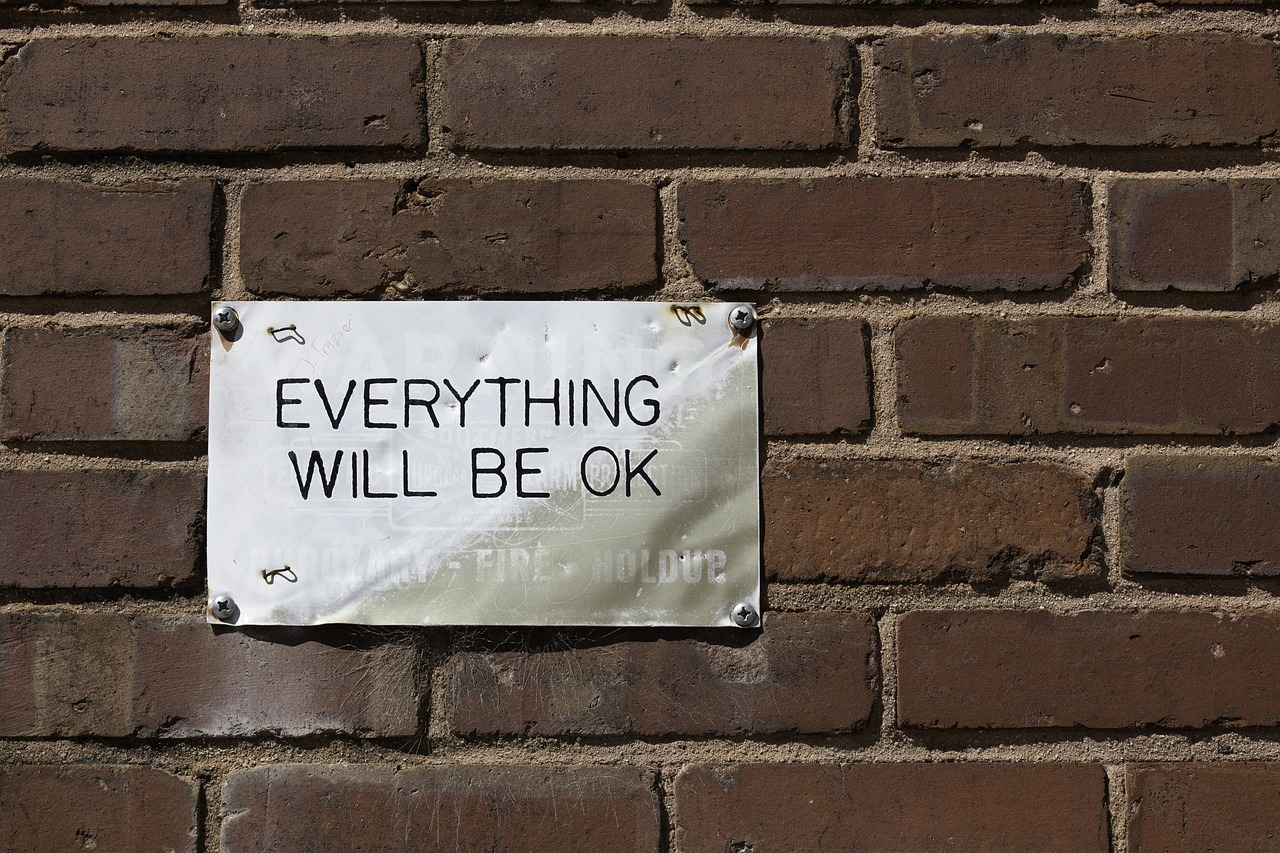
Characteristics of a Growth Mindset
When we talk about a growth mindset, we're diving into a world of possibilities and potential. Imagine viewing challenges not as roadblocks, but as stepping stones to greater achievements. One of the most striking characteristics of individuals with a growth mindset is their openness to feedback. They see constructive criticism as a valuable tool for improvement rather than a personal attack. This willingness to learn and adapt is crucial in building resilience, as it allows them to bounce back stronger after setbacks.
Another defining trait of a growth mindset is perseverance. People with this mindset don’t give up easily. They understand that failure is often a part of the journey to success. Instead of being discouraged by failures, they analyze what went wrong, learn from it, and try again. This relentless pursuit of improvement fosters a sense of emotional strength that helps them navigate life's ups and downs.
Additionally, individuals with a growth mindset tend to embrace challenges. They view difficult tasks as opportunities to stretch their abilities and grow. This contrasts sharply with those who possess a fixed mindset, who might shy away from challenges out of fear of failure. It’s like training for a marathon; the more you push your limits, the stronger and more resilient you become. As you face and overcome challenges, you build a robust foundation of confidence and capability.
Furthermore, a growth mindset encourages curiosity. Those who embody this mindset are often eager to learn new things, explore unfamiliar territories, and seek out experiences that expand their horizons. This innate curiosity fuels their desire to improve, making them more adaptable in the face of change. They understand that learning is a lifelong journey, and this perspective not only enhances their skills but also enriches their emotional well-being.
To sum it up, the characteristics of a growth mindset include:
- Openness to feedback - Embracing constructive criticism as a pathway to improvement.
- Perseverance - The determination to keep going despite obstacles.
- Embracing challenges - Viewing difficult tasks as opportunities for growth.
- Curiosity - A desire to learn and explore new things.
By cultivating these traits, you can enhance your resilience and develop a mindset that not only withstands challenges but thrives because of them. Remember, adopting a growth mindset is like planting a seed; with the right care and nurturing, it can blossom into something truly remarkable.
Q: What is a growth mindset?
A growth mindset is the belief that abilities and intelligence can be developed through dedication and hard work. It fosters a love for learning and resilience essential for great accomplishments.
Q: How can I develop a growth mindset?
You can develop a growth mindset by embracing challenges, learning from criticism, and celebrating your efforts and progress rather than just the outcome.
Q: What are the benefits of having a growth mindset?
Having a growth mindset can lead to greater resilience, improved problem-solving skills, and a more positive outlook on life, ultimately enhancing your overall well-being.
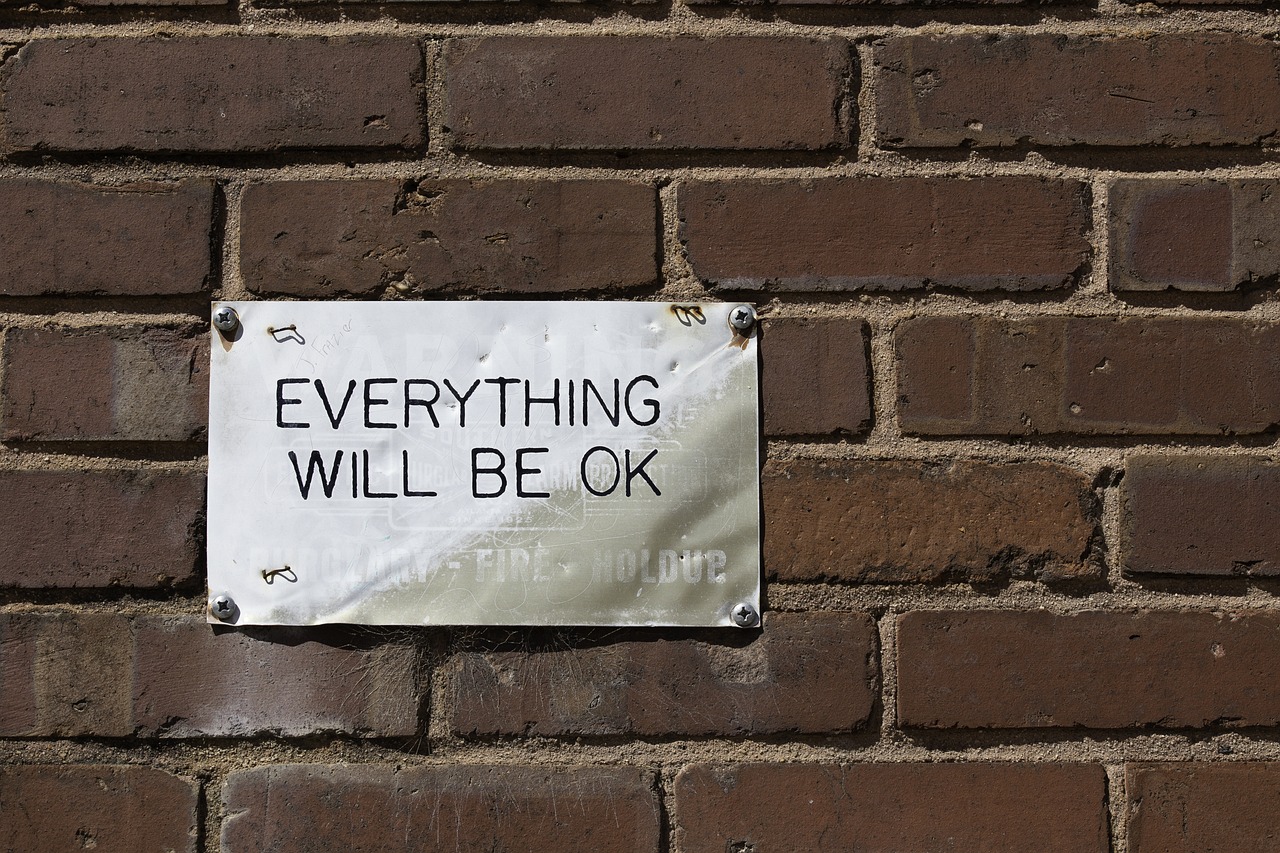
Shifting to a Growth Mindset
Shifting to a growth mindset is like flipping a switch that illuminates a whole new perspective on challenges and failures. Instead of viewing obstacles as dead ends, you start to see them as opportunities for growth. This transition is not just a one-time event; it’s a continuous journey that requires commitment and practice. So, how do you begin this transformative process? Let’s dive into some practical steps that can help you embrace a growth mindset and enhance your resilience.
First and foremost, it’s crucial to acknowledge your current mindset. Take a moment to reflect on how you typically respond to setbacks. Do you find yourself feeling defeated, or do you seek lessons from the experience? By recognizing your default reactions, you can start to identify areas where a mindset shift is needed. This self-awareness is the first step toward change.
Next, consider the power of language. The words you use can significantly influence your mindset. Instead of saying, “I can’t do this,” try reframing it to, “I can’t do this yet.” This simple switch in language opens up possibilities and encourages a more optimistic outlook. It’s all about fostering a dialogue within yourself that promotes growth and exploration rather than limitation.
Another effective strategy is to embrace challenges rather than avoid them. It might feel uncomfortable at first, but stepping outside your comfort zone is where the magic happens. When you tackle difficult tasks, you not only build your skills but also develop a sense of achievement that reinforces your growth mindset. Remember, every challenge is a chance to learn something new!
Additionally, surround yourself with supportive individuals. The people you interact with can greatly influence your mindset. Seek out friends, mentors, or communities that encourage growth and resilience. Engaging with others who share a growth mindset can inspire you to adopt similar attitudes. It’s like being part of a team where everyone is cheering each other on to reach new heights.
Finally, practice self-reflection regularly. Take time to assess your progress and celebrate small victories, no matter how insignificant they may seem. Keeping a journal can be an excellent way to document your thoughts and feelings throughout this journey. This practice not only helps you recognize your growth but also reinforces the belief that you are capable of change.
In conclusion, shifting to a growth mindset is a powerful tool for building resilience. It requires conscious effort and a willingness to embrace challenges, but the rewards are well worth it. By fostering a positive dialogue, surrounding yourself with supportive people, and engaging in self-reflection, you can cultivate a mindset that not only withstands setbacks but thrives because of them.
- What is a growth mindset? A growth mindset is the belief that abilities and intelligence can be developed through dedication and hard work.
- How can I develop a growth mindset? You can develop a growth mindset by embracing challenges, learning from feedback, and reframing negative thoughts into positive ones.
- Why is a growth mindset important for resilience? A growth mindset helps you view setbacks as opportunities for growth, making it easier to bounce back from difficulties.
- Can self-compassion aid in developing a growth mindset? Absolutely! Self-compassion allows you to treat yourself kindly during tough times, which can strengthen your resilience and growth mindset.

Building Daily Habits
When it comes to building resilience, daily habits are like the sturdy bricks that form the foundation of a strong house. Just as a house needs a solid structure to withstand storms, our emotional well-being requires consistent practices that help us bounce back from life's challenges. So, how do we go about creating these daily habits that fortify our resilience? It all starts with intentionality. You need to consciously choose activities that promote emotional strength and adaptability.
Think of your daily routine as a canvas on which you can paint your resilience. Each brush stroke represents a habit that contributes to your overall emotional health. For example, incorporating mindfulness meditation into your morning can set a positive tone for the day. It allows you to center your thoughts, reducing anxiety and helping you approach challenges with a clearer mind. Similarly, engaging in regular physical activity not only boosts your mood through the release of endorphins but also equips you with the stamina to face obstacles head-on.
Another important aspect of building daily habits is the power of reflection. Taking a few moments at the end of each day to reflect on what went well and what could be improved can significantly enhance your resilience. This practice not only helps you learn from your experiences but also reinforces a growth mindset. You might ask yourself questions like, “What challenges did I face today, and how did I handle them?” or “What can I do differently tomorrow?” This self-inquiry fosters a sense of control and self-awareness, which are critical components of resilience.
Moreover, it’s essential to surround yourself with positive influences. This could mean spending time with friends and family who uplift you, or even engaging with motivational content—be it books, podcasts, or videos. The idea is to create an environment that nurtures your emotional strength. You might also consider keeping a gratitude journal. Writing down things you are thankful for can shift your focus from what’s going wrong to what’s going right, reinforcing a positive outlook.
To help you visualize these daily habits, here’s a simple table that outlines some effective strategies:
| Habit | Description | Benefits |
|---|---|---|
| Mindfulness Meditation | Daily practice to center your thoughts and reduce anxiety. | Improves focus and emotional regulation. |
| Physical Activity | Engaging in regular exercise, such as walking or yoga. | Boosts mood and builds physical resilience. |
| Reflection | End-of-day self-inquiry about challenges and successes. | Enhances self-awareness and growth mindset. |
| Gratitude Journal | Writing down things you are thankful for. | Shifts focus to positive aspects of life. |
Ultimately, the key to building resilience through daily habits is consistency. Just like a muscle, resilience needs to be exercised regularly to grow stronger. Start small—choose one or two habits to integrate into your daily routine and gradually build from there. Remember, it’s not about perfection; it’s about progress. Each small step you take contributes to your ability to navigate life’s ups and downs with grace and strength.
- What are some quick habits to build resilience? Simple habits like deep breathing, gratitude journaling, and daily exercise can significantly enhance your resilience.
- How long does it take to build resilience? Building resilience is a gradual process. Consistent practice over weeks and months can lead to noticeable improvements.
- Can resilience be learned? Absolutely! Resilience can be developed through intentional practices and a supportive environment.

Practicing Self-Compassion
When life throws challenges your way, it’s easy to fall into the trap of self-criticism. Instead of beating yourself up over mistakes or setbacks, practicing self-compassion can be a game changer. Think of self-compassion as your emotional safety net; it cushions your falls and helps you rise again. By treating yourself with kindness and understanding during tough times, you not only foster emotional resilience but also enhance your overall well-being.
Self-compassion involves three core components: self-kindness, common humanity, and mindfulness. Self-kindness means being warm and understanding toward ourselves when we suffer, fail, or feel inadequate, rather than being harshly critical. Recognizing our shared humanity helps us understand that everyone struggles, making it easier to connect with others and feel less isolated. Lastly, mindfulness encourages us to observe our thoughts and feelings without judgment, allowing us to acknowledge our pain without becoming overwhelmed by it.
So, how do you cultivate self-compassion in your daily life? Here are some effective techniques:
- Mindfulness Meditation: Set aside a few minutes each day to practice mindfulness. Focus on your breath and observe your thoughts without judgment. This can help you become more aware of your inner dialogue and foster a kinder mindset.
- Positive Self-Talk: Challenge negative thoughts by replacing them with positive affirmations. Instead of saying, "I'm such a failure," try, "I’m doing my best, and it's okay to make mistakes."
- Journaling: Write down your feelings and experiences. Reflecting on your thoughts can help you process emotions and develop a more compassionate view of yourself.
Incorporating these practices into your routine doesn't have to be overwhelming. Start small—perhaps by dedicating just five minutes a day to mindfulness or journaling. Gradually, you’ll find that self-compassion becomes a natural part of your emotional toolkit. The more you practice self-compassion, the more resilient you’ll become, enabling you to face life’s ups and downs with grace and strength.
The benefits of self-compassion are profound. People who practice self-compassion tend to experience reduced anxiety, better emotional regulation, and an overall increase in life satisfaction. In fact, studies have shown that self-compassion can lead to greater resilience in the face of adversity. It’s like having an internal cheerleader that reminds you that it’s okay to stumble and that you have the strength to get back up.
Ultimately, self-compassion is not just about feeling good; it's about fostering a mindset that empowers you to embrace life fully, with all its imperfections. When you learn to be kind to yourself, you open the door to greater emotional strength and adaptability, making it easier to navigate challenges and setbacks.
1. What is self-compassion?
Self-compassion is the practice of treating yourself with kindness and understanding during difficult times, rather than being overly critical.
2. How can self-compassion improve resilience?
By fostering a kinder inner dialogue, self-compassion helps you recover from setbacks more effectively and encourages a positive outlook on challenges.
3. Can self-compassion help with anxiety?
Yes, practicing self-compassion can significantly reduce anxiety levels by promoting emotional regulation and a sense of connection with others.
4. How do I start practicing self-compassion?
Begin with small steps, such as mindfulness meditation, positive self-talk, and journaling, to gradually integrate self-compassion into your daily life.

Techniques for Self-Compassion
Embracing self-compassion is like wrapping yourself in a warm blanket on a chilly night; it provides comfort and security when life gets tough. But how do we cultivate this essential quality? Here are some effective techniques that can help you nurture self-compassion in your daily life.
One powerful technique is to practice mindfulness. Mindfulness allows you to become aware of your thoughts and feelings without judgment. Imagine sitting quietly, focusing on your breath, and acknowledging the feelings that arise without criticism. This practice creates a safe space where you can experience your emotions fully and understand that it's okay to feel vulnerable. By recognizing your pain without harsh self-judgment, you pave the way for self-compassion.
Another technique involves positive self-talk. Often, we are our harshest critics, berating ourselves for mistakes or shortcomings. Instead, try to reframe those negative thoughts. For example, instead of saying, "I'm such a failure," replace it with, "It's okay to make mistakes; they are part of learning." This shift not only fosters a kinder inner dialogue but also encourages resilience by viewing setbacks as opportunities for growth.
Engaging in self-soothing activities can also enhance self-compassion. Think of activities that bring you joy or relaxation, like taking a warm bath, reading a favorite book, or going for a nature walk. These moments of self-care remind you that you deserve kindness and love, especially during challenging times. When you prioritize your well-being, you reinforce the idea that you are worthy of compassion.
Additionally, consider writing a self-compassion letter. This technique involves writing a letter to yourself as if you were a dear friend who is struggling. Express understanding, empathy, and encouragement in your words. This exercise not only helps you articulate your feelings but also allows you to view your situation from a more compassionate perspective. When you read the letter back, you'll likely feel a sense of warmth and acceptance that can be incredibly healing.
Lastly, remember that self-compassion is a skill that takes practice. Just like building muscle at the gym, the more you practice these techniques, the stronger your self-compassion will become. Celebrate small victories along the way, and don’t be too hard on yourself when you stumble. Each step forward is a testament to your commitment to nurturing your emotional well-being.
Incorporating these techniques into your daily routine can significantly enhance your ability to be kind to yourself. As you cultivate self-compassion, you'll find that your emotional resilience grows, helping you navigate life's ups and downs with greater ease.
- What is self-compassion? Self-compassion involves treating yourself with kindness and understanding during difficult times, rather than being harsh or critical.
- How can mindfulness help with self-compassion? Mindfulness allows you to observe your thoughts and feelings without judgment, creating space for self-acceptance.
- Can self-compassion improve my mental health? Yes, practicing self-compassion can reduce anxiety and increase emotional resilience, leading to improved overall well-being.
- How do I start practicing self-compassion? Begin by incorporating mindfulness, positive self-talk, and self-soothing activities into your daily routine.
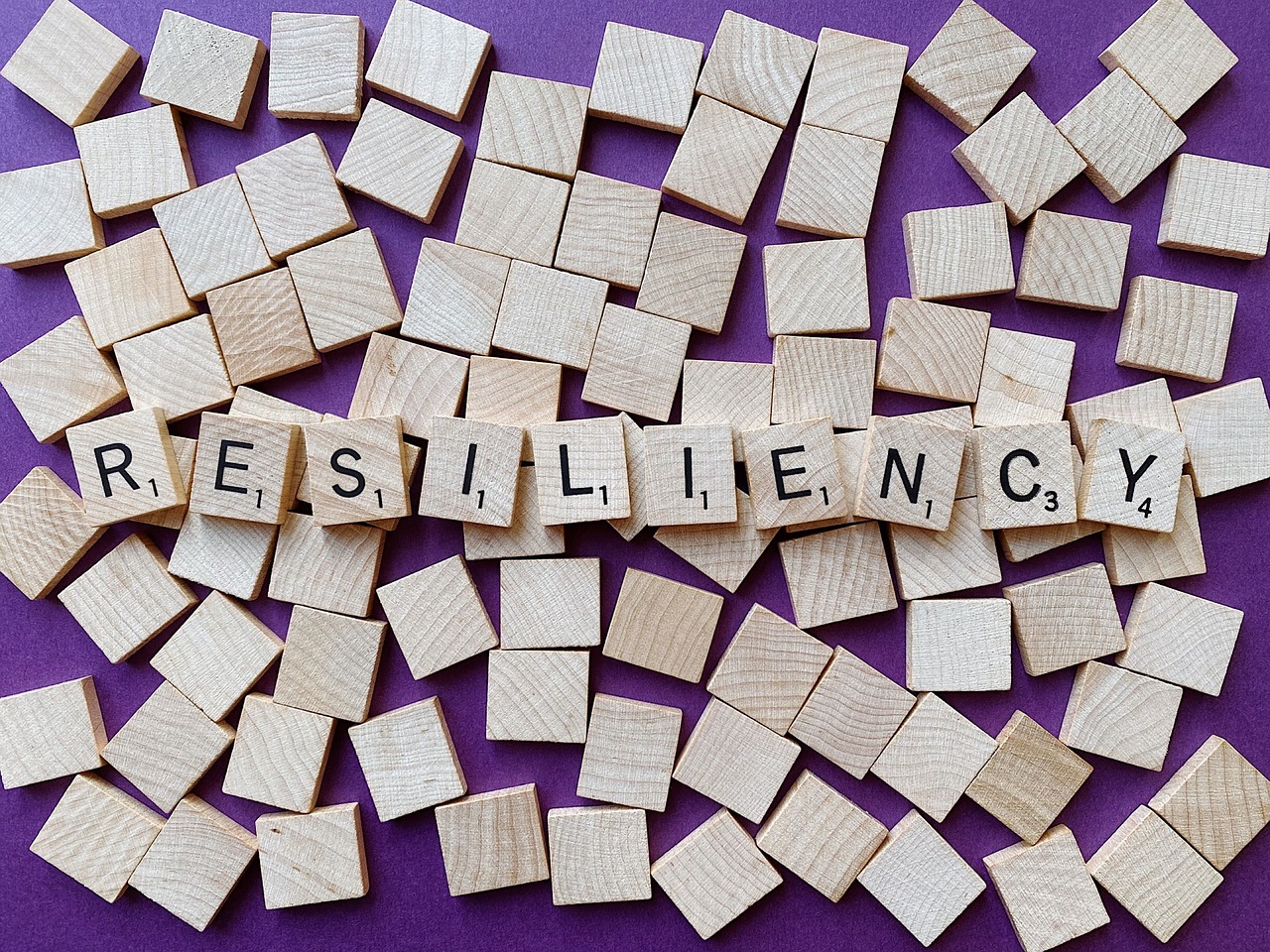
Benefits of Self-Compassion
Self-compassion is not just a trendy buzzword; it's a powerful tool that can transform the way we navigate life's ups and downs. When we practice self-compassion, we treat ourselves with the same kindness and understanding that we would offer to a good friend. This shift in perspective can lead to a multitude of benefits that enhance our emotional resilience and overall well-being.
One of the most significant benefits of self-compassion is its ability to reduce anxiety. When we are compassionate towards ourselves, we create a safe space to experience our emotions without judgment. This acceptance helps to alleviate the pressure we often place on ourselves to be perfect, which can lead to chronic stress and anxiety. Instead of spiraling into negative thoughts, a self-compassionate approach allows us to acknowledge our feelings and move through them with grace.
Moreover, self-compassion fosters a greater sense of emotional resilience. By recognizing that everyone makes mistakes and faces challenges, we can cultivate a mindset that views setbacks as opportunities for growth rather than insurmountable obstacles. This perspective shift is crucial during tough times, as it empowers us to bounce back stronger and more determined. Think of it as building an emotional safety net; when we fall, self-compassion helps us land softly, allowing us to get back up with renewed strength.
Additionally, self-compassion can significantly improve our relationships with others. When we are kind to ourselves, we are more likely to extend that kindness to those around us. This creates a ripple effect, fostering a supportive and understanding environment that benefits everyone involved. In contrast, self-criticism often leads to defensiveness and isolation, which can strain relationships. By embracing self-compassion, we open the door to deeper connections and a stronger support network.
To illustrate the benefits of self-compassion further, consider the following table that outlines some key advantages:
| Benefit | Description |
|---|---|
| Reduced Anxiety | Self-compassion helps alleviate stress by fostering acceptance of our feelings. |
| Increased Resilience | Encourages a growth mindset, allowing us to view challenges as opportunities. |
| Improved Relationships | Promotes kindness towards others, strengthening social connections. |
| Enhanced Emotional Regulation | Helps manage emotions more effectively, leading to better decision-making. |
In conclusion, the benefits of self-compassion are profound and far-reaching. By embracing this practice, we not only improve our relationship with ourselves but also enhance our ability to cope with life's challenges. So, the next time you find yourself in a tough spot, remember to treat yourself with kindness. It’s a small shift that can lead to monumental changes in your emotional landscape.
- What is self-compassion?
Self-compassion involves treating oneself with kindness and understanding during difficult times, rather than being harshly self-critical.
- How can self-compassion help with anxiety?
By fostering acceptance of our feelings, self-compassion reduces the pressure to be perfect, which can alleviate anxiety.
- Can self-compassion improve my relationships?
Yes! When you are kind to yourself, you are more likely to extend that kindness to others, enhancing your social connections.
- What are some ways to practice self-compassion?
Mindfulness, positive self-talk, and reflection on shared human experiences are effective techniques for cultivating self-compassion.
Frequently Asked Questions
-
What is resilience and why is it important?
Resilience is the ability to bounce back from setbacks and challenges. It’s crucial because it helps individuals cope with stress, adapt to change, and maintain a positive outlook even during tough times. By building resilience, you enhance your emotional strength and improve your overall mental health.
-
How can I develop a growth mindset?
Developing a growth mindset involves embracing challenges, learning from criticism, and viewing failures as opportunities for growth. Start by recognizing your fixed beliefs and consciously shifting them. Practice self-reflection and seek feedback to foster a more adaptable and open mindset.
-
What daily habits can help build resilience?
To build resilience, consider incorporating habits such as regular exercise, mindfulness meditation, and setting achievable goals. Establishing a consistent routine can also provide a sense of stability and control, making it easier to navigate life's ups and downs.
-
How does self-compassion contribute to resilience?
Self-compassion involves treating yourself with kindness during difficult times, which can significantly enhance emotional resilience. By practicing self-compassion, you reduce negative self-talk and foster a supportive inner dialogue, making it easier to recover from setbacks.
-
What techniques can I use to practice self-compassion?
Some effective techniques for practicing self-compassion include mindfulness exercises, journaling your feelings, and using positive affirmations. These practices help you acknowledge your struggles without judgment and encourage a nurturing attitude towards yourself.
-
What are the benefits of being self-compassionate?
Being self-compassionate can lead to reduced anxiety, improved emotional resilience, and a greater overall sense of well-being. It allows you to manage stress better and enhances your ability to cope with life's challenges, ultimately improving your quality of life.













